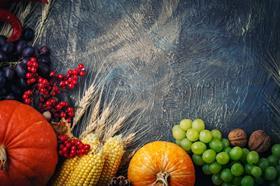
Local sourcing and seasonal produce are the buzzwords du jour in the world of fine dining, while the country’s leading chefs are increasingly looking to their suppliers for expert advice in shaping menus.
As the summer drifts into early autumn, menus are at a critical turning point – chefs are using seasonal English produce such as squash, with the first new-season topfruit just around the corner. Root veg is another welcome addition to autumn menus, but chefs aren’t just interested in standard orange carrots – turnips, parsnips and heritage varieties are just as likely to feature as the trend for colourful veg-led recipes continues.
Beside the seasonal changes there is a wider movement for even greater emphasis on provenance in foodservice, with restaurants going further than just stating that produce is British-grown. “With strawberries, restaurants no longer just state English strawberries, they give the variety name,” says Vernon Mascarenhas, of foodservice supplier First Choice Produce, adding that this is often to state that they’re not Elsanta.
“Diners want provenance – they like the info about where their carrots are from. Asparagus is a big one and most restaurants will now name the area or county. On things like apples and pears they want to say we have something like Orange Pippin.”
Elliott Lidstone, head chef of much-talked about Bristol restaurant Box-E, agrees that provenance is “still standing strong” and says he sources locally wherever possible in produce, as well as cheese and drinks. First Choice and Total Produce are two of Box-E’s key suppliers, and Lidstone says he also receives micro cress deliveries from local Bristol firm Grow Bristol, which delivers produce by bike.
“We did a farm visit down to Somerset when the asparagus was in season to New Cross Farm, and the next day we were cooking with it, it was lovely,” he says. “They also grow greengages and plums down there – it was lovely meeting the farmer and seeing the farm. It makes a big difference to see where it’s grown and make the connection.”
Mascarenhas says one of his biggest roles with First Choice is to work closely with chefs to keep them up to date on new product arrivals. One trend to watch this year is variegated kale, he says, with dark green, pink and white varieties that can be shredded, glazed and eaten raw. “We’ve got to be in front for the next trend, which is why I work with seed companies a lot,” he explains. “My growers bespoke grow specifically for chefs. One of the big differences in how we source is for instance on carrots, we plant and harvest on a weekly basis, rather than planting a whole field. Growers produce smaller volumes and more products for a higher price.”
Working with growers is less of a concern for Jan Wilson, chef and co-owner at fellow Bristol outlet Wilsons, which sources much of its produce from a couple of acres of its own land.
“It’s exciting for us to have the farm, it keeps the team really motivated,” he explains. “From my perspective, I work 15-hour days, five days a week, so it’s easy to lose that link with nature. To be able to go to the farm keeps me inspired. We have to supplement what we’re growing but the dream is to be self-sufficient.”
Sourcing has become something of a USP for Wilsons, with Wilson himself often shooting wood pigeons and other game for the menu. The restaurant was built around core values of sourcing wild meat and foraging, and Wilson also has a preference for vegetable-based cooking. “All of our dishes are very vegetable-led,” he says. “Lots of chefs choose a bit of meat and then work the dish around that, whereas we like to make the vegetable the centre.”
At Box-E, Lidstone says one exciting new product he likes is wild fennel pollen, also known as Spice of Angels. “That’s a really lovely product that you can sprinkle on top of things like courgette. It’s pretty expensive, but has a lovely smell and flavour of liquorice and aniseed,” he says. “I’m always interested in new varieties. We’re also looking at some Herefordshire rainbow chard at the moment.”
Meanwhile, Wilson believes dining habits are changing, with a current à la carte menu looking very different to the traditional and often meat-based formulas of years ago. “We have a dish at the moment with charred cabbage and mussels. The cabbage is grilled and charred and is very much the centre of the plate. We also have a dish with salt-crusted turnips, which we bind with seaweed,” he says.
“That’s the food I want to cook. I want the best ingredients on the plate and not hidden. Get a really delicious potato and treat it with respect, it takes more skill to do that.”
It all adds up to an exciting time for foodservice suppliers, and it’s clear those working closely with both chefs and growers will continue to be best placed to shape the trends of tomorrow.



